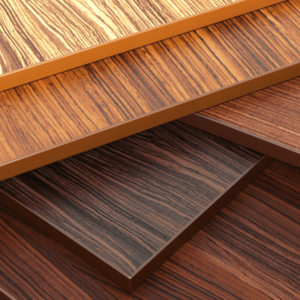Description
Cherry Plywood
As it matures, cherry veneer, sometimes referred to as quartered cherry wood veneer or quarter cut American cherry veneer, takes on a lovely reddish brown hue. It is offered in 4′ x 8′ and 4′ x 10′ sizes as sheets of wood on wood veneer with a PSA (pressure sensitive adhesive) option, FlexVenTM 10 and FlexVenTM 20 paper backed, Tuf-PliTM polyback, or Pli-FlexTM wood on wood veneer. As a special order, 8′ x 4′ cross grain quartered cherry veneer is also offered.
The grain normally runs along the 8′ dimension and is book matched. Rift cut cherry is another name for quarter cut cherry. Standard A grade cherry wood veneer typically permits a few flaws, such as sporadic pin knots and tiny dark resin areas called “gum pockets.” Cherry is a hardwood with a satiny texture and a close, consistent grain that is robust and simple to work with. Slight figure or flashing is another typical grain feature. Although cherry veneer can take stains and finishes well, it is typically given a clear coat finish to protect the warmth and beauty of the wood’s original color.
Medium reddish brown in tone, cherry veneer quickly darkens. Due to exposure to light and air, its natural hue will become four to five shades deeper. It has a smooth, mainly even grain with some wavy effects, a fine texture, and a rich appearance. If desired, it stains well to replicate mahogany and has a stunning shine when finished. Cherry veneer is stained darkly by most woodworkers. The dark markings all over cherry veneer that are called “gum” are frequently present. From the less expensive architectural grade, which is devoid of knots and gum, to the more expensive lower grade, the cost of cherry veneer is modest.
Cherry plywood is regarded as a premium hardwood kind. It is dense, incredibly tough, and long-lasting. It also tends to cost a little bit more due to these characteristics. The color “Cherry” reflects the name even though the word “Cherry” alludes to its tree of origin. While the sapwood of cherries is often light pinkish, the heartwood is typically a deep reddish brown. Heartwood is the tougher, denser interior of the tree trunk. The softer outer layer that lies between the heartwood and the bark is called sapwood, on the other hand. The ratio of sapwood to heartwood in cherry wood is typically 25% to 75%.
Black Cherry trees, which typically grow throughout North America but are also common in Europe, Central America, and South America, are the source of cherrywood. Long before the arrival of the Europeans, the wood and fruits of the tree were cultivated throughout Central and South America. Now, it can be grown anywhere plants are. Additionally traded and utilized all over the world is cherrywood.
<< Click Here To Contact Factory >>

Cherry Plywood Features
With the help of our cherry plywood veneers, you can effortlessly add a touch of class to any space in your house or place of business. Cherry veneer plywood is perfect for woodworking applications and is simple to put over drywall. This enables you to add refined elegance and attractive character to your environment. Cherry plywood can be found in a variety of widths and thicknesses to suit your specific requirements.
Plain sliced heartwood veneers from cherry plywood are book matched and provide a fine, straight, and close-grained wood with just minimal color differences. The wood is pale pink to reddish brown in color. Faces are constructed from a variety of parts.

Application
Since cherry plywood is strong and appealing, many people prefer to use it to create furniture like cabinets. Although it is less frequently used for wall panels, cherry plywood is also excellent for flooring.
Cherry plywood flooring is popular because it resists damage effectively. Various musical instruments, other architectural designs (such decorative wall panels, doors, and other fixtures), packing or boxes (particularly those used for tool storage), toys, and playground equipment are some more uses for cherry plywood. Although less frequent, it can also be used to produce a variety of sporting equipment, including lacrosse sticks.
Environmental
Compared to the production of other building materials, cherry plywood is often produced with less energy. The development of wood processing technology has made it possible to manufacture products with less energy usage and less greenhouse gas emissions.
If you want an accurate quote, please feel free to contact us










